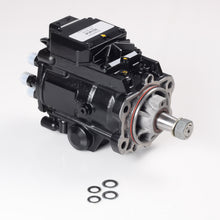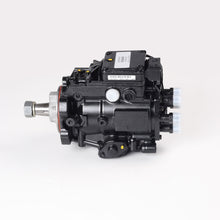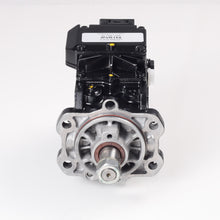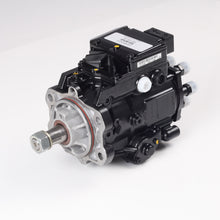1998.5-2002 DODGE CUMMINS ISB VP-44 INJECTION PUMP IPVR-15X 0470506027
Regular price
$1,595.00
Sale
Diesel System Services specializes in the Cummins ISB engine used in the Dodge, RV and industrial applications. Issues with the ISB center around the VP-44 injection pump and fuel system.  Loss of fuel supply is the normal cause of premature injection pump failure. Fuel supply problems are normally the result of a weak or failed lift pump which results in injection pump fuel starvation and overheating. The stock lift pump supply output starts to weaken typically around 45-55,000 miles and is completely out of specified supply specifications around 65-85,000 miles. The lift pump usually will give little or no indication of a failure until it’s too late. When a lift pump fails it is designed to go into by-pass, allowing the vain pump in the VP-44 to continue to pull fuel. Once the VP-44 is put in an inadequate supply situation internal injection pump damage begins. The indications of an internal damaged VP-44 will be loss of mileage, slight loss of power, hard starts, intermittent power loss or bucking, and P0216 or P1693 fault code which may or may not trigger the check engine light. A P0216 fault code is the result of the VP-44 injection pump not achieving pump timing value commanded by the engine ECM.
Loss of fuel supply is the normal cause of premature injection pump failure. Fuel supply problems are normally the result of a weak or failed lift pump which results in injection pump fuel starvation and overheating. The stock lift pump supply output starts to weaken typically around 45-55,000 miles and is completely out of specified supply specifications around 65-85,000 miles. The lift pump usually will give little or no indication of a failure until it’s too late. When a lift pump fails it is designed to go into by-pass, allowing the vain pump in the VP-44 to continue to pull fuel. Once the VP-44 is put in an inadequate supply situation internal injection pump damage begins. The indications of an internal damaged VP-44 will be loss of mileage, slight loss of power, hard starts, intermittent power loss or bucking, and P0216 or P1693 fault code which may or may not trigger the check engine light. A P0216 fault code is the result of the VP-44 injection pump not achieving pump timing value commanded by the engine ECM.  Depending on how long the pump is out of its commanded timing range will determine whether or not the engine ECM passes this code onto the PCM and triggers the check engine light. If you check for fault codes with a scan tool that is only capable of pulling codes from the PCM side, the only code you typically get is a P1693. This code is a companion code, meaning that the PCM has been informed that there is a problem in the engine ECM, but the ECM has not relayed the exact code and you will have to communicate directly with the ECM to find out what the exact code is. This will take a scan tool or Cummins Insite that is capable of communicating with the engine ECM. Cummins trouble shooting and repair manuals will outline performing a lift pump pressure/volume check and replacement of the lift pump if it does not meet specifications in order to cure a P0216 fault code condition. It has been our experience 99% of the time that replacing the lift pump does not cure a P0216 fault code. The only way to fix the problem is to replace the VP-44 injection pump. The VP-44 has gone through many revisions and up dates to help address issues, some of these have been addressing the timing plunger and plunger bore problems and updating the housing. The one area that is still in need of improvement by the OEM is in the lift pump. There have been bulletins and revisions to the original lift pump from Cummins but there are still problems with it. Cummins has even come out with a lift pump campaign kit that comes with a pressure sensor that turns on the check engine light and de-rates engine power when the supply pressure drops below 3.5 psi. The problem with this kit is it only covers certain engine serial numbers that have the right ECM and it won’t work on Dodge applications. Chrysler has gone away from the Cummins supply pump and gone with an in tank pusher pump. The Problem with this pump is that it only puts out 8 psi and is not enough if you are running a chip or programmer. Pressure tends to drop dangerously low under load. Most people complain to their dealership of the low pressure situation shortly after having the pump installed. The dealerships have been instructed to inform customers that “It’s a higher volume pump then the original one so the pressure is less.” The problem with this statement is, if you increase flow and the fuel system restrictions stay the same such as hose size, fuel filter, over flow valve, etc. Then the pressure increases. Put your thumb over the end of a hose with the tap half open, you will feel a certain amount of pressure, now turn the tap to the full open position you will feel a further increase in pressure as the volume is increased against your thumb. The way their pump is set up is it is regulated at a set pressure with most of the fuel by-passing in the tank. As fuel demands increase the regulator will by-pass less fuel in the tank and will try and maintain its set pressure to the VP-44 injection pump. What the Chrysler’s pump tries to do is maintain a more constant pressure and volume. Unfortunately it’s not enough to keep up with the fueling demands of the VP-44 under certain loads (towing) and if you’re running fueling modifications such as a chip and bigger injectors. We recommend that you run a fuel pressure gauge or a low pressure warning indicator if you plan on running a stock supply pump. Also if you are getting up in mileage or don’t know what condition your lift pump is in, give us a call and we will check it out.
Depending on how long the pump is out of its commanded timing range will determine whether or not the engine ECM passes this code onto the PCM and triggers the check engine light. If you check for fault codes with a scan tool that is only capable of pulling codes from the PCM side, the only code you typically get is a P1693. This code is a companion code, meaning that the PCM has been informed that there is a problem in the engine ECM, but the ECM has not relayed the exact code and you will have to communicate directly with the ECM to find out what the exact code is. This will take a scan tool or Cummins Insite that is capable of communicating with the engine ECM. Cummins trouble shooting and repair manuals will outline performing a lift pump pressure/volume check and replacement of the lift pump if it does not meet specifications in order to cure a P0216 fault code condition. It has been our experience 99% of the time that replacing the lift pump does not cure a P0216 fault code. The only way to fix the problem is to replace the VP-44 injection pump. The VP-44 has gone through many revisions and up dates to help address issues, some of these have been addressing the timing plunger and plunger bore problems and updating the housing. The one area that is still in need of improvement by the OEM is in the lift pump. There have been bulletins and revisions to the original lift pump from Cummins but there are still problems with it. Cummins has even come out with a lift pump campaign kit that comes with a pressure sensor that turns on the check engine light and de-rates engine power when the supply pressure drops below 3.5 psi. The problem with this kit is it only covers certain engine serial numbers that have the right ECM and it won’t work on Dodge applications. Chrysler has gone away from the Cummins supply pump and gone with an in tank pusher pump. The Problem with this pump is that it only puts out 8 psi and is not enough if you are running a chip or programmer. Pressure tends to drop dangerously low under load. Most people complain to their dealership of the low pressure situation shortly after having the pump installed. The dealerships have been instructed to inform customers that “It’s a higher volume pump then the original one so the pressure is less.” The problem with this statement is, if you increase flow and the fuel system restrictions stay the same such as hose size, fuel filter, over flow valve, etc. Then the pressure increases. Put your thumb over the end of a hose with the tap half open, you will feel a certain amount of pressure, now turn the tap to the full open position you will feel a further increase in pressure as the volume is increased against your thumb. The way their pump is set up is it is regulated at a set pressure with most of the fuel by-passing in the tank. As fuel demands increase the regulator will by-pass less fuel in the tank and will try and maintain its set pressure to the VP-44 injection pump. What the Chrysler’s pump tries to do is maintain a more constant pressure and volume. Unfortunately it’s not enough to keep up with the fueling demands of the VP-44 under certain loads (towing) and if you’re running fueling modifications such as a chip and bigger injectors. We recommend that you run a fuel pressure gauge or a low pressure warning indicator if you plan on running a stock supply pump. Also if you are getting up in mileage or don’t know what condition your lift pump is in, give us a call and we will check it out.
When upgrading the fuel supply pump I recommend going with a FASS or HPFP after market fuel supply systems. I have been installing them for over 5 years now and have had nothing but very good results with these systems. The FASS and HPFP pumps come with a 6 year warranty. Cummins stands behind their pump, (WAAAY BEHIND IT!!!) with a 6 month warranty. I have also started to see papers that come with new lift pumps stating under certain conditions its ok to have 0 psi supply pressure. If this is true then why is Cummins putting a low pressure indicator in the fuel supply side on certain ISB engines, that once pressure drops below 3.5 psi the check engine light comes on and the engine ECM de-rates engine power to warn the driver of a low fuel pressure problem?
Fuel supply is important in keeping the injection pump components and electronics cool and to keep them lubricated. It’s also important to maintain the fuel filter and not to drive on empty. The excessive fuel not used during combustion is used to lubricate and cool the injection pump and injectors and is returned to the tank to dissipate the heat. If the fuel volume in the tank is low the heated fuel will be returned to the VP-44 and the rest of the fuel system causing these components to run hotter than they normally would if the tank was full. Also fuel lubricity goes away with excessive heat making life on the VP-44 that much harder. Since the switch to ultra low sulfur fuel it is important to run additive in every tank full of fuel.
Other codes that indicate a failed VP-44 injection pump, also known as death codes and will require VP-44 replacement are the following;
| INSITE Cummins codes |
SAE Chrysler P codes |
| 366 | P1284 |
| 367 | P0370 |
| 368 | P0216 |
| 374 | P1688 |
| 375 | P0602 |
| 376 | P1691 |
Diesel System Services offers quality rebuilt VP-44 injection pumps that come with the latest up dates and are rebuilt by Bosch certified technicians. Beware of cheap rebuilt pumps. There are more and more injection shops out there cutting corners on their rebuilt pumps trying to undercut the competition and make a buck by reusing parts that are to be replaced or updated to current Bosch standards. Prices have been going up on the parts that are used to rebuild these pumps. All shops are on the same pricing structure for the parts used. The only way they can be a lot less in price is if they are not replacing and updating a lot of the parts in their rebuilt pumps.
All stock VP-44’s come with a one year warranty.
Hot rod VP-44’s are also available for Dodge applications and come with a one year warranty.
Warranty conditions are that the lift pump is replaced at the time of VP-44 injection pump replacement or proof that the lift pump has already been recently replaced or fuel supply system has been upgraded.






